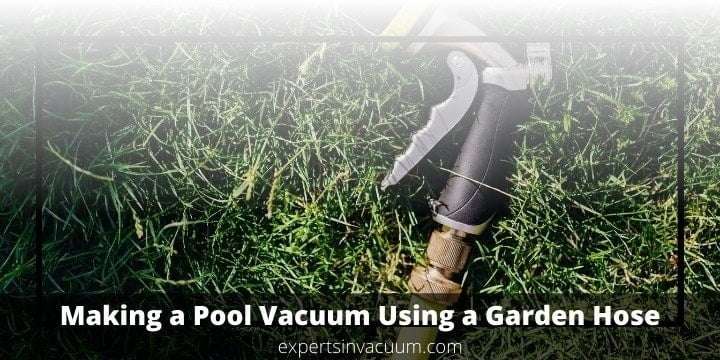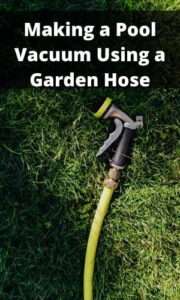Pool vacuums are engineered to clean debris that settles at the bottom of a swimming pool. However, you can also use a homemade pool vacuum using a garden hose as an alternative to a commercial pool vacuum cleaner. It is a cheaper option if your pool pump is faulty.

You may be wondering how to make a pool vacuum using a garden hose. There are various requirements and procedures that you need to follow to do so, and this article provides you with the ultimate guide to making the garden hose vacuum.
Continue reading to learn more on how to make a pool vacuum using a garden hose.
In this post we will cover:
- How to Make a Pool Vacuum Using a Garden Hose
- Using a garden hose pool vacuum to vacuum my pool
- What to consider when buying a garden hose
- Different Types of Garden Hoses & Uses
How to Make a Pool Vacuum Using a Garden Hose
Requirements
There are several items that you will require to make the garden hose vacuum and they include a garden hose, which is a rubber-made flexible tube. The ends of the tube are open and can be fitted into various devices for various functions.
The garden hose can be old or new, but make sure it covers your pool’s length from top to bottom. Therefore, we recommend a hose that is at least 25 feet in size. To ensure that water flows freely through the hose, it should have tangle-free movement and no kinks.
The second is a plastic funnel, which you will need to be able to cover a larger surface area when cleaning. The garden hose’s intake port has a smaller size, and that covers a smaller surface area, making it time-consuming.
If you do not have a plastic funnel, you can use a 500ml plastic bottle and cut it at a 45-degree angle.
The third is a telescopic pole, which is essential for manual pool cleaning. The pole is used to skim water to capture debris that floats in pool water. You can also fit it into a brush and use it to clean the walls of your pool.
The fourth is a vacuum bag, which is a significant component of a vacuum cleaner. It is the one that creates suction and prevents debris from getting back into the pool as you clean. The bag supplies suction pressure to the vacuuming tool.
The Procedure to Follow
After assembling these items, you can now make your garden hose vacuum using the procedure below:
Step 1: Make sure that the garden hose you are using is of the right length based on the size of your pool. A small inflatable kiddie pool does not need a long garden hose, but a permanent pool with shallow and deep ends warrants a garden hose of a reasonable length.
Step 2: once you have determined the length, connect one end of the garden hose to the vacuum bag. Ensure the bag is connected to the appropriate end of the hose. That is the end with a valve attached to it to create the right suction pressure.
Step 3: First, remove the telescopic pole from the leaf skimmer. If the handle has attachment pins, apply pressure to disorganize them so that you can remove the handle. Secondly, you can twist the leaf skimmer portion to remove the handle.
Fit the telescopic handle to the garden hose and fit the remaining end of the hose with a handle hose that fits the telescopic handle. If you come across any fitting problems, tie the end of the hose to the telescopic garden using a clean rope.
How can I use a garden hose pool vacuum to vacuum my pool?
Step 1: Once you have fitted the telescopic handle to the garden hose, use it to lower the vacuum in the pool while holding it firmly. The handle should touch the pool’s bottom to provide the garden hose with a good surface area.
Reaching the bottom portion of your pool will enable you to vacuum the pool quickly and eliminate all debris and harmful materials from it.
Step 2: Before siphoning with the garden hose, ensure that you have a designated drainage point where the pool water will go. Then start vacuuming the pool.
Step 3: Slowly scan through the pool’s floor while paying particular attention to the dirtiest parts to give the garden hose pipe enough time to suck water. Repeat the process several times to get clean water and a healthy pool.
Negative pressure will be created within the garden hose pipe by the suction that creates pressure in the pool. The low pressure created in the bag will allow even fine dirt and debris to be collected.
Step 4: After thoroughly cleaning the pool, gently remove the garden hose vacuum from the pool. Do this slowly to prevent stirring the dirt collected in the water. Then clean the pole and hose and securely store them for future use.
Conclusion
You can clean even the dirtiest part of your pool using a garden hose vacuum made from a garden hose and a vacuum bag. The main element is the vacuum bag, which creates suction through negative pressure.
You can make a pool vacuum using a garden hose at home by yourself without the help of a professional. Just follow the simple steps that we have highlighted above and you will create the cleaning tool.
Using the garden hose vacuum is very simple as it works just like a pool vacuum cleaner. Make sure to disconnect the parts after using the garden hose vacuum and clean them before storage.
FAQs
What to consider when buying a garden hose
The material: The type of material that the garden hose is made of is important since materials vary in quality and lifespan. Rubber hoses are better because they are more durable since they can endure extreme weather conditions.
However, the best quality is made of polyurethane since they guarantee all-weather durability, which makes them expensive. If properly maintained, such hoses can last for more than a decade.
Diameter: Garden hoses range from 3/8 to ¾ with the biggest being 5/8 inches in diameter. A bigger diameter carries more water, but it will also make the hose heavier.
Water hose fittings: A garden hose connects to the source of water using brass or plastic fittings. Plastic fittings break easily and have a shorter lifespan. Brass fittings are heavier, resistant to rust, and more durable.
Therefore, choose one that lasts longer and is easier to use.
The length and thickness of the hose: The thickness is determined by the number of layers used in manufacturing, which starts from two-ply to six-ply.
The ones that are strongest and resistant to cracking and bending are those with six-ply layers. The length should be at least 25 feet.
PSI: This is the water speed or flow rate and pressure in a hose, which is measured in pounds per square inch (PSI). This is usually indicated in the packaging of the hose. The tougher the hose, the higher the PSI.
Toxic-free: Choose a garden hose that is toxic-free and the best way to be sure is to buy one made of polyurethane tested and graded by NSF and FDA. Also, ensure that the fittings are lead-safe.
What are the Different Types of Garden Hoses and their Best Uses?
A garden hose is a flexible tube used for watering gardens or lawns and for landscaping purposes. There are different types of garden hoses and they include the following:
Traditional garden hoses: these are all-purpose and can be used in different capacities, such as washing a car, hosing down a patio, and watering a lawn. The hoses can be found in a length range of 25 to 100 feet, which is 8 to 30 meters.
Vinyl garden hoses wear faster and kink easily. Rubber hoses tend to last longer and hold up well. However, they are heavier and more difficult to move or store.
Expandable/Pocket hoses: These are expandable because when filled with water, they expand three times the size of their length.
They are great for small jobs but have a shorter life span as they quickly wear out in the sunlight and easily rupture under high water pressure.
Flat hoses: These resemble a smaller version of a fireman’s hose since they remain flat until water is turned on. The hoses drain well and are lightweight and easy to store.
Flat hoses are used for construction and irrigation purposes. In a construction project, they are used to water the walls. They can also be used for flood clean-up purposes.
The downside is that they are made of vinyl, which kinks easily and has a shorter lifespan. The hoses do not work well around corners and are best used in a straight line.
Coiled hoses: The hoses are ideal for smaller areas. When not in use, they shrink back to a tight spiral and can be easily tucked in on a balcony or patio.
The downsides are that coiled hoses are difficult to store and the actual length may be slightly less than the one indicated on the label.
Sprinkler hoses: These hoses are perforated and send out a misty spray in an area that is at least 10 feet wide, or three meters. The hoses work with the tiny holes facing up or facing down to be used as soaker hoses.
Soaker hoses: these are made of recycled rubber or plastic and are porous. The hoses work by allowing water to seep into the soil, where plant roots efficiently utilize moisture.
The hoses are used for watering gardens, shrubs, vegetable beds, and areas surrounded by trees. The hoses are suitable for leveled landscapes with straight lines. The hoses can be quickly deteriorated by sunlight.
Soak and spray hoses: These allow you to control the direction and flow of water as you water your garden. The combination hoses provide you with the advantage of a soaker and traditional hoses. The hoses can be used to water various plants and most beds.
Commercial grade hoses: these are made for industrial usage and are durable and strong. The hoses are studier since they are resistant to sunlight and other harmful factors.
The hoses have a long lifespan, and that makes them expensive. The hoses are used by professional gardeners with big gardens.

Related Post